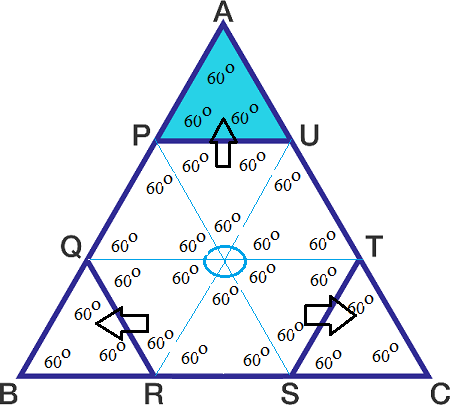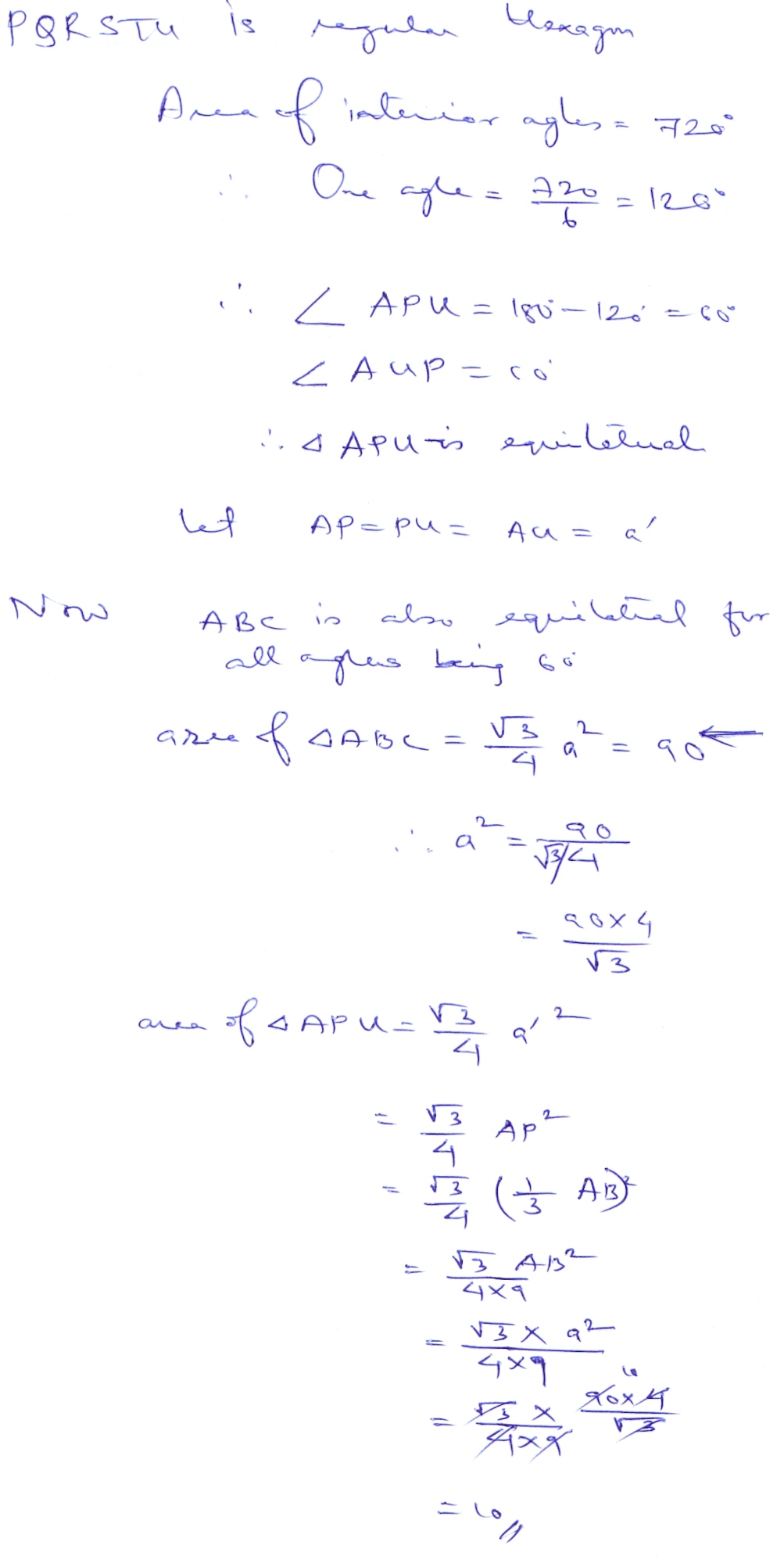Find the shaded area
In the figure to the right, P Q R S T U is a regular hexagon.
Sides P Q , R S , and T U are extended to form triangle A B C .
If the area of triangle A B C is 90, then find the area of the shaded region.
This section requires Javascript.
You are seeing this because something didn't load right. We suggest you, (a) try
refreshing the page, (b) enabling javascript if it is disabled on your browser and,
finally, (c)
loading the
non-javascript version of this page
. We're sorry about the hassle.
11 solutions
@Pi Han Goh @Ojasee Duble @Chew-Seong Cheong @Peter van der Linden
Thanks. I had cleaned up the phrasing of the problem to make it clear that the vertices of the hexagon lie on the sides of the triangle. I understand it can be frustrating having to infer the intentions of the problem creator.
I've cleared out the comment chain about "It assumed that the positions of P,Q,R,S,T,U are specified, which is not". Sorry for the confusion.
Nice visual solution!! :-D
i divided the hexagon into 6 equalateral triangles ,plus the 3 extendeded ones ,giving 9 altogether ,one ninth of 90 = 10 !
Log in to reply
Yup, the key point is to identify that we can divide △ A B C into nine triangles congruent to △ A P U , so they will all have the same area.
That's how I solved it! Nice.
I did that but I skipped the diagram step. Its an equalateral triangle so that helps. I just visualised...
Log in to reply
Then I saw that the sides were divided into thirds, so I did 1/3x1/3=1/9
Relevant wiki: Length and Area Problem Solving

Given that it is regular hexagon. Hexagon has 6 equilateral triangle. while extend it we will get three more same equilateral triangle.
The shaded region = 9 1 and the total area =90
Therefore, the Area of the shaded region = 9 9 0 =10
Are all the nine triangles in this figure of equal area? How do we know?
Agnishom is right. For completeness, you need to state why all the 9 triangles are of equal area. Do you know how to do that?
@Agnishom Chattopadhyay & @Pi Han Goh I modified the diagram and added the required inputs. Hope now it will be clear.
Since the interior angle of regular hexgon is 1 2 0 ∘ and on calculating the each interior triangle is 1 8 0 ∘ − 1 2 0 ∘ = > 6 0 ° This shows are triangle are equilateral moreover, triangle A B C is also an equilateral triangle.
Let the total length of triangle ABC be A. Then
4 3 A 2 = 9 0
If s be the side length of small triangle. Then A = 3 s Plugging A = 3 s in above equation
4 3 ( 3 s ) 2 = 9 0
4 3 s 2 = 1 0
Where do you get 4 3 A 2 = 9 0 ? What formula is that?
It's the formula to calculate the area of an equilateral triangle. where A ( assumed) is the length of the equilateral triangle
Log in to reply
I see. You could mention that in your solution to clear things up! :)
Thank you for the advice. :)
Since all the triangles are equilateral they all have the same area and so the answer becomes like this:
Number of triangles Total area of the triangle = area of a single triangle
So 9 9 0 = 10
Good job! The key point is to understand that △ A P U is an equilateral triangle, and that △ A B C can be divided into 9 triangles congruent to △ A P U
Yeah exactly!
Can you plz upvote my solution
Triangles BQR, STC, and PAU are of the same area. Their total area comprises 1/3 of the area of the overall triangle, as a hexagon is equivalent to 6 small triangles here, comprising 2/3 of the area of the overall triangle. To find a small triangle's area, set up the equation as follows: 9a = 90. "a" is the area of the small triangle indicated on the illustration -- solving for it gives us 10.
Yuppers~ This is correct.
Isn't it fascinating that a regular hexagon can fit 6 non-overlapping equilateral triangles? I wonder which other regular n -gon has this equivalent property as well....
Log in to reply
I might try to experiment on which n-gons can fit non-overlapping equilateral triangles; but so far, only the hexagon had this property. Who knows that we can derive a formula for that?
This is a valid solution. I appreciate the fact that you carefully proved that the triangle is indeed equilateral
It is it hard to prove that the three triangles that are cut off are equilateral. Let's say the length of the side of the given triangle is x, then the length of PU is obviously 3 1 x. So the area of triangle PUA is ( 3 1 ) 2 ⋅ 9 0 = 1 0 .
It would be great if you showed why the triangles cut off are equilateral. It will help others who cannot solve this problem understand your solution better.
they are equilateral because the interior angles of the hexagon are each 120 degrees, making the adjacent angle 60. If two angles of a triangle are 60, the third angle is 60. equilateral.
It's pretty obvious for me...
Make 9 triangles and divide it equally
Can you elaborate more on how to make 9 triangles?
I got 10 by using the formula for area of an equilateral triangle. A=1/4(root3) times side squared. I used 3s for a side and solved for s (one side of the small equilateral triangles. Then I used s to calculate the area of one of the small triangles.
Why is the side of the smaller triangle exactly a third of the larger triangle?
There are 9 triangles inside of hexagon
I do not see why. Can you explain?
Triangle ABC is scale factor x3 of triangle APU. This means, area of ABC is 'scale factor squared' of area APU. Let area APU = y and area ABC = 90 (given). So, y x 3x3 = 90; hence y = 90/9 = 10.
This is indeed a valid intuition and is a great way to solve the problem
However, it remains to check that A B C is really a scale 3 factor of A P U . And that the area of the scaled triangle varies with the square of the side lengths.

It can be easily seen from the figure above that the shaded region △ A P U is one of the nine equilateral triangles with side length of the hexagon. Since area of △ A B C is 90, the area of △ A P U is 9 9 0 = 1 0 .